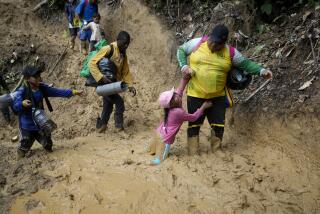Child Labor on the Rise, UNICEF Says
- Share via
UNITED NATIONS — In South Asia, children as young as 8 work in matchstick factories, as cigarette rollers or at carpet looms after being turned over to industrialists by their parents in return for a small loan.
In Brazil, an estimated 3 million children labor on tea, sugar cane, tobacco and sisal plantations and account for more than 40% of work-related accidents.
In Haiti, 7-year-old housemaids fetch water, cook meals and look after the children of their employers.
In upstate New York, a 1990 study found Mexican American children working in farm fields that were still wet with pesticides.
And worldwide, private aid agencies estimate as many as 1 million girls a year are lured or forced into prostitution.
These accounts and others are included in a report on child labor around the globe released by the United Nations Children’s Fund on Wednesday, the agency’s 50th anniversary.
The study concludes that child labor is rising in many countries, propelled by increased poverty, mounting school dropout rates and reduced government spending on education and social services.
“We are working to ensure that exploitative and hazardous child labor becomes as unacceptable in the next century as slavery has become in this,” Carol Bellamy, UNICEF’s executive director, told a news conference. “Children should be students in school, not slaves in factories, fields or brothels.”
The vast majority of child labor is in the developing world, the report concludes. Much of it is in remote areas or is done within the family; accurate statistics, thus, are difficult to arrive at.
But UNICEF estimates that there are 250 million child workers, ages 5 to 14, in the Third World. One in three children in Africa works, as does one in five in Latin America, the report says.
About half the world’s child workers are Asian, though UNICEF says the situation may be improving in Southeast Asia as per-capita income and education levels rise and family size decreases.
The report also notes that there is child labor in the United States on farms and in garment factories and cites British estimates that 15% to 26% of 11-year-olds in Britain are working.
The report implicates parents of many child workers in their plight.
“Of all the work children do, the most common is agricultural or domestic work within their own families,” it says.
Much of this work goes beyond normal household chores to include toil that prevents children from attending school.
Unusually pernicious, the report notes, is the practice of “bonding” children to an employer as payment for a loan to their family, a loan that often is never paid off. While this is most prevalent in India, Nepal and Pakistan, researchers also found examples in Brazil, Mauritania and Myanmar, formerly known as Burma.
Much child labor is born of the desperation of poverty.
“For poor families, the small contribution of a child’s income or assistance at home that allows the parents to work can make the difference between hunger and bare sufficiency,” the report states. “A review of nine Latin American countries has shown that without the income of working children aged 13-17, the incidence of poverty would rise by between 10% and 20%. . . . The parents of child laborers are often unemployed or underemployed, desperate for secure employment and income. Yet it is not they but their children who are offered the jobs. Why? Because children can be paid less, of course.”
The report also criticizes some policies of the World Bank and the International Monetary Fund, which it says has led some indebted nations of the developing world to cut spending on health, education, food subsidies and social services to the poor.
While acknowledging that child labor is a “complex issue” sustained by market forces as well as cultural traditions, the report calls for immediate elimination of the most hazardous child work as well as an expansion of free and compulsory education, toughened labor laws and enforcement of employer codes of conduct.
More to Read
Sign up for Essential California
The most important California stories and recommendations in your inbox every morning.
You may occasionally receive promotional content from the Los Angeles Times.










